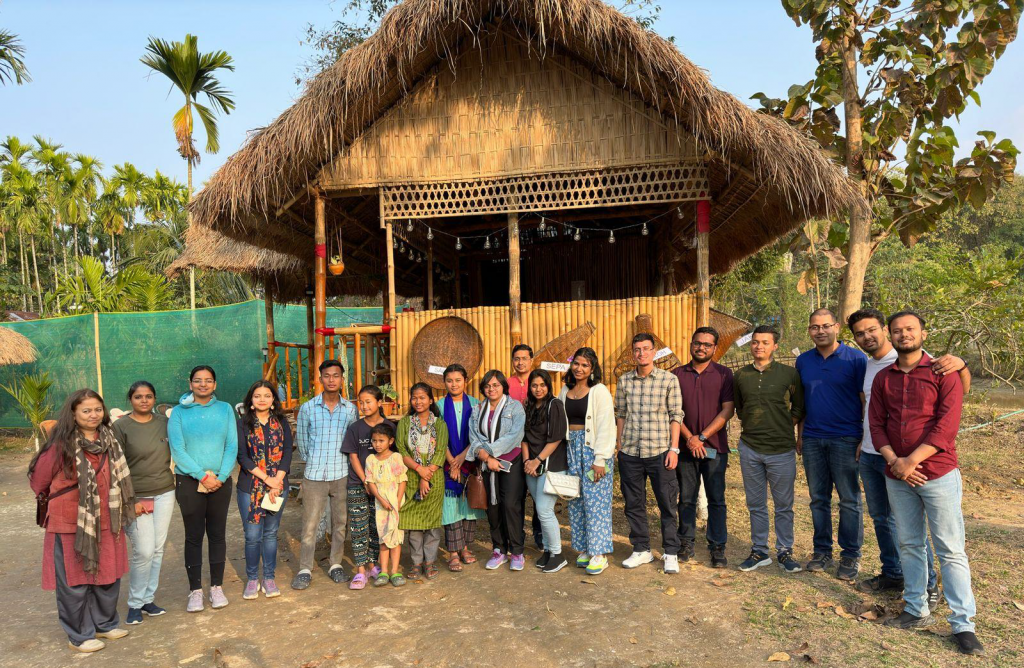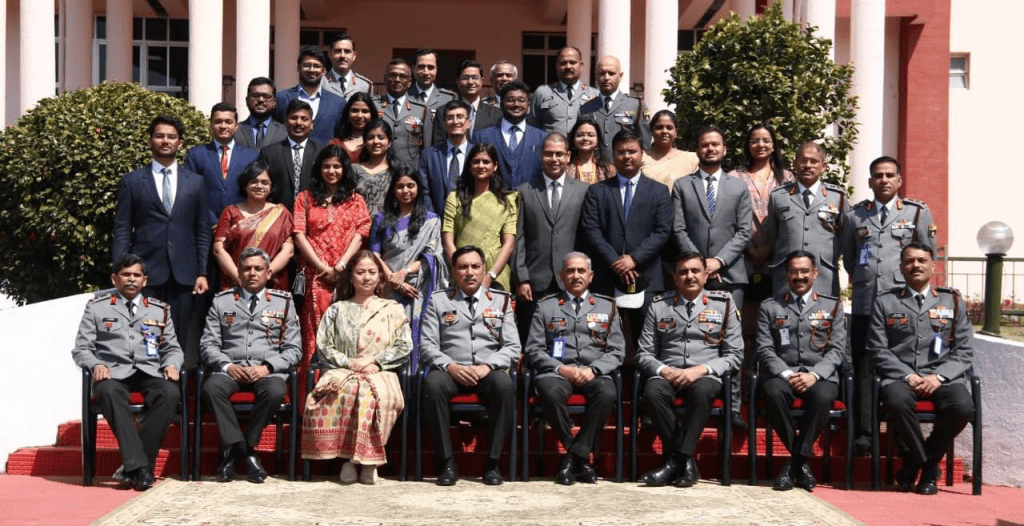North East India has always fascinated me. I was privileged to be part of the Defence cum North East Attachment of the Indian Information Service (IIS) Officer Trainees (OTs) of 2021 and 2022 Batch between 22 February to 05 March 2023.
This attachment was part of the training curriculum designed by IIMC and approved by the Ministry.

The first leg of the journey started in the early morning of 22 February from IGI Airport New Delhi. I along with other OTs embarked on a flight to Guwahati. It was an inexplicable experience to watch the sunrise from the flight. We reached Guwahati covering almost 2500km in 3 hours. On way to Guwahati city from the Airport, we could see tall coconut trees lined on both sides of the road.
World-famous Beepor Beel was also en-route. My heart was saddened to see this beautiful wetland crumbling under the brunt of human encroachment. Piles of waste were littered at the banks of the lake. After reaching Guwahati City, I did quickly put the luggage in the hotel room and gobbled lunch. After that, we hurried to meet DG PIB (NE) B Narayanan. He welcomed us with traditional Assamese Gamosa and traditional Assamese sweets. We discussed the challenges that the Government is facing in information dissemination in this remote region and also possible solutions to it.
The next morning after visiting the holy shrine of Kamakhya Temple, we embarked on a long journey to Kaziranga National Park (KNP). Kaziranga National Park is classified as a UNESCO world heritage site for its richness in flora and fauna.
The road to Kaziranga National Park crisscrosses fertile Brahmaputra plains dominated by paddy fields. Human habitation was also present in patches along the highway. We reached Kaziranga National Park in the late evening and rested in a nearby Resort.
On 24th Feb we woke up early to enjoy an elephant safari inside Kaziranga National Park. Early morning safaris are best suited for elephants as they easily get exhausted in the heat of the day. During 45 minutes of safari, the first encounter was with pair of Rhinos. These majestic creatures were grazing gently. The next sight was of Mom and Calf Rhino. Mom Rhino was instinctively shielding her calf from the inquisitive eyes of visitors. The Last sight was of Single Rhino taking bath in a water hole. A water buffalo was also grazing nearby.

Soon, the sun was up above the hills and we winded up our safari. On the way back, we greeted these working jumbos by offering them bananas. The very fact that we were able to see 5 Rhinos in such a little span of time explains the abundance of Rhinos inside Kaziranga National Park.
A Mahaut told us that elephants are allowed to make only 3 rides in a day. They are paid by Kaziranga National Park officials on monthly basis from fees collected from visitors. He said that he devotes a fair share of those earnings towards fodder and the upkeep of his elephant. Kaziranga National Park officials also keep a close eye on elephants to prevent their overuse or exploitation.
That afternoon, we visited A Kuki tribal village in Karbi Anglong District. The village has been supported by local NGO groups to promote tribal tourism. At our arrival, a group of lady villagers performed their ceremonial dance to welcome us at the beats of traditional khol and taal. A few OTs joined them to boost their spirit.
After welcoming us, they served us a hand-cooked meal in a tribal way. The food was fresh and delicious. The rice-made beverage was very refreshing. We not only drank a lot of it but also asked them to pack it for our dinner. A representative from NGO gave a presentation on how they are making efforts to support tribal villages by promoting tourism. In the end, Villages demonstrated their traditional way of fishing and paddy cultivation.
The next day, we visited the Director of Kaziranga National Park at his office. He proudly informed us that Kaziranga National Park is home to 70% of the Great One Horn Rhino population in India. Kaziranga National Park is being used as a source for the reintroduction of Rhinos in other National parks and wildlife Sanctuaries across Assam. Recently half a dozen Rhinos have been sent to Pobitora Wildlife Sanctuary for repopulation. He applauded the selfless service of forest guards in collaboration with local Police in controlling Rhino poaching and smuggling of other wild animals.
That afternoon, we again took a 2-hour Jeep Safari to Kaziranga National Park. For the first hour, it was disappointing to see nothing but tall grasses on both sides of the dirt road. There were patches of trees in between. These trees were having distinct buttresses at the lower trunk to give additional support in the unstable floodplains. But as the sun gradually came down to the horizon, Park became lively. We saw herd after herd of deer cautiously grazing the green shoots in open areas. A Rhino was grazing close by; tourists were prompt in capturing the beast with their cameras.
The next encounter was with a herd of Wild Buffalos; they were grazing fearlessly in the tall grass. While returning we were mesmerized to see the herd of wild elephants crossing the waterhole. An old Female elephant was leading the herd, calves were in the middle and another jumbo was at the end. Elephants have evolved this mechanism to protect their offspring from predators like Tiger. we came back to the hotel with the unmet desire of watching the majestic Royal Bengal Tiger in wild.

National Highway 715 separates Kaziranga National Park from Karbi Anglong Hills. This Highway has multiple animal crossings. These crossings allow wild animals to migrate from Kaziranga National Park to hills, especially during annual floods. There is a speed restriction along the Highway and cameras have been installed to enforce it. Even after that many animals lose their lives in vehicular collisions.
On 26th Feb early morning, we set off for Shillong. During the afternoon we stopped at a roadside restaurant to have lunch.
As we entered Meghalaya, the topography suddenly changed. We found ourselves on the curved roads in the beautiful Khasi Hills.
As the sun started to descend, the sky became red. We stopped at Umiam Lake viewpoint to enjoy the sunset. We reached Shillong after travelling more than 250 km journey in close to 7 hours and rested for the night. Since Shillong is situated so far in the east, its sun rises almost 1 hour 30 minutes earlier than in Delhi.
The next morning, our caravan proceeded to Cherapunji. It is quite a windy place. Grass blades were turning yellow on the rocky plateau in absence of rain. Though Cherapunji is the wettest place on earth, it receives almost all of its rain in the months of April to October. The rest of the months are usually dry. Next, we went to the Sohbar bridge on the Wahrew river near Bangladesh Border and enjoyed the clean water. On the way back, we went to Mawsmai Caves. It is a natural cave curved in limestone by flowing water. Though we had only 45 minutes before Cave is closed for the day, we enjoyed every second of that.
On 28th Feb IIS OTs called on ADG Assam Rifles Lt Gen DK Singh at ARHQ Shillong. Prof Rinku Pegu on behalf of IIMC gave a memento to ADG. ADG hosted high tea to welcome us and honored us with Golf Cap having the emblem of Assam Rifles i.e. “The Dhai Murti”.

Dhai Murti Depicts an Assam Rifles soldier escorting a war widow and her child during WWII. Later afternoon, we visited Assam Rifles Museum and paid our respect to fallen soldiers at War Memorial. Cementing memories of Shillong into our hearts, we once again came back to Guwahati for the next leg of our journey. The batch was bifurcated into two groups. One comprising 12 OTs was to fly to Imphal (Manipur) and the other comprising 7 OTs to Aizawl (Mizoram). I fell into the Mizoram group.
The next morning, I along with my group flew to Lengpui Airport. It is the closest airport to Aizawl. It took close to 1 hour to reach the Battalion HQ of Assam Rifles in Aizawl from the airport. We quickly dressed in formal and went to meet Brigadier Girish Upadhya.
He briefed us about the issues arising out of shared ethnicities across the Indo-Myanmar border and issues related to the smuggling of drugs and other contraband items emanating from the Golden Triangle. We also had a discussion on Military rule in Myanmar, Conflicts between various insurgent groups, and the Refugee crisis that India is facing because of it.
To get an on-ground experience, we expressed our desire to visit Champhai. Champhai is considered the epicenter of all the illicit drugs and liquor coming from Myanmar to Mizoram. We were received by the local unit commander there. He exposed us to night patrolling, search, and seizure of contraband items. We also interacted with the soldiers and experienced the threats and difficulties that they face in the line of duty. At late-night, we came back to our guest house and called it a day.
On 3rd March, we went to the Zokhawthar border crossing. This tiny town is connected to Myanmar via the Indo-Myanmar Friendship bridge. Though on the Indian Side, we have a customs office, it remains largely empty because, after a coup in Myanmar, formal trade is suspended. The Major of Assam Rifles commanding local Unit informed us about the recent skirmish that took place between Myanmar Army and the Chin National Army Insurgent Group just across the Tiau river that forms a natural boundary between these two neighbors.

On the way back to Champhai, we visited the Chapchar kut festival ground where young boys and girls were performing the traditional Cheraw dance. We also went to a de-addiction centre supported by Assam Rifles to understand the menace drugs are causing to Mizo society. The next day we came back to Aizawl via under construction NH6. NHDCIL is upgrading the carriageway of this road to four lanes. After completion, this road will provide seamless connectivity to Aizawl from Indo-Myanmar Border.
On 5th March, we bid adieu to North East after presenting a memento to Assam Rifles as a token of appreciation. The untouched beauty of North East will always be imprinted in my heart. I will always be grateful to the local people for the warm reception they extended to us. Their simplistic way of living is the harbinger of the sustainable development message. The way they have woven their life around their tribal identity is mesmerizing. I wish to keep visiting North East again and again.
(About the Author and Photographer: Deepak Dwivedi is an Indian Information Service Officer of 2022 Batch currently undergoing training at IIMC New Delhi. As per the training curriculum, Deepak Dwivedi along with other Officers Trainees went to North East-cum-defence attachment with Assam Rifles between 22 Feb to 5 March 2023 and has written a travelogue on his trip. This is his first travelogue)
Read more: Latest



